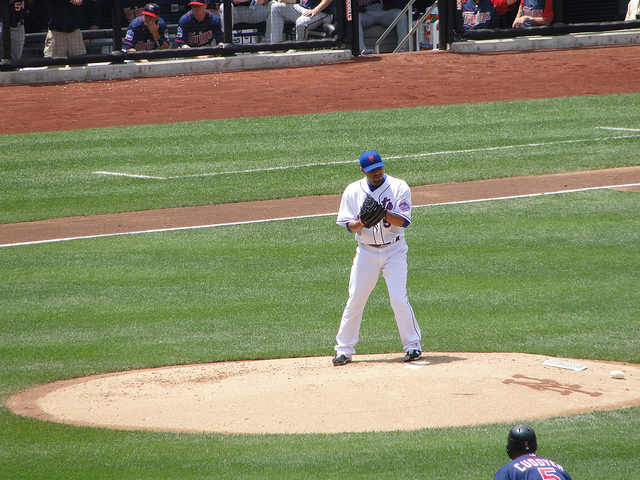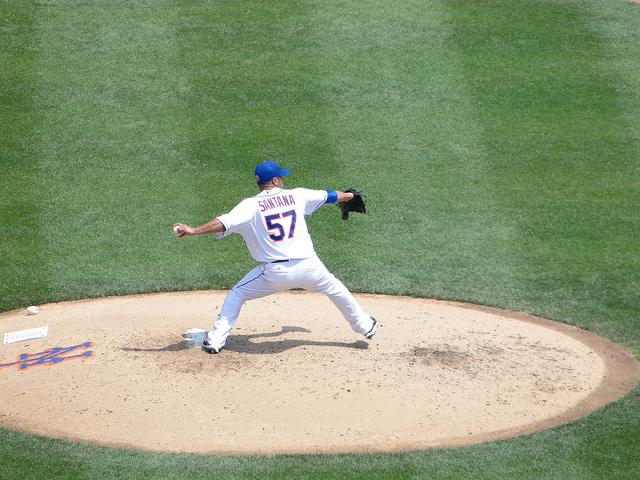
The years Johan Santana spent with the Mets are mostly a blur at this point, but I still remember the day they got him like it was yesterday.
It was a couple of days before the first Giants-Patriots Super Bowl, and there was all sorts of buzz that a long-rumored deal for Santana might finally go down. I had the day off from the baseball site I worked for, and since I didn’t yet use Twitter, I stayed glued to the couch refreshing MetsBlog.com, which had forecasted Santana to the Mets for two months. (Say what you will about them, and you’d probably be correct, but they were all over this one.)
As the afternoon waned, MetsBlog put up a matter-of-fact post relaying that the Mets had completed a deal for Santana. I stared at the screen and attempted to wrap my brain around the words. This was no Mike Hampton or Tom Glavine, or even an awesome to watch but past his prime Pedro Martinez. The consensus best pitcher in baseball, the shiniest of new toys, was coming to my favorite team since I was a kid. I pictured the jersey I’d wear, the summer nights I’d spend watching him, the potential championships.
It did, of course, make me slightly uneasy that Santana’s velocity had been trending down, and that he was striking out progressively fewer batters every year. But damn the torpedoes, the Mets had imported the new millenium version of Doc Gooden, and I couldn’t be happier.
*****
Over the next five years, Santana would become a textbook illustration of why you have to develop your own young pitchers, lest you feel forced to pay big money for free-agent arms with plenty of mileage on them already.
After an excellent first season, Santana’s Mets tenure devolved into one injury after another until his shoulder disintegrated for the second and perhaps final time. In between, he left two indelible memories: a magnificent shutout with a torn-up knee the next-to-last day of the 2008 season that kept the Mets alive until the inauspicious finale one day later, and of course, the first no-hitter in Mets history last June.
The no-hitter was treasured by most Mets fans, removing one very significant line item off the long list of things held over their head as second-class baseball citizens. There was also a great deal of consternation among those who believed the extra 30 or so pitches with a surgically repaired shoulder previously on a short leash expediated his ruination.
For my part, I cringed at every pitch he threw from about the seventh inning on, while fully knowing he’d never in a million years come out of the game. But pitchers historically don’t come back from capsule tears and succeed; his shoulder was most likely a ticking time bomb regardless. I mean, honestly, who really knows?
And if anyone was going to throw the first no-hitter in the 40-year history of the team, it might as well be someone as talented and elegant on the mound as Santana. It simply wouldn’t have held the same historical mystique had it been, say, the odious Steve Trachsel.
*****
I recall watching Santana pitch in person three times. The first was a five-run clunker against the Twins in June 2010, eminently forgettable except that it was his first start after he was accused of rape by a woman in Florida. Johan was booed that day, though it seemed more the halfhearted sort that goes along with a mediocre start, and less due to the reminder that superhuman athletic gifts in no way inoculate someone from being pathetically flawed.
 (It does, however, generally get them a pass in most cases. I don’t recall reading about Johan’s golf course improprieties in any of the eulogies I read for his Mets career this week. It would have gotten in the way of retellings of his no-hitter.)
(It does, however, generally get them a pass in most cases. I don’t recall reading about Johan’s golf course improprieties in any of the eulogies I read for his Mets career this week. It would have gotten in the way of retellings of his no-hitter.)
The third and final time I saw Santana pitch, I went to a Mets-Braves game for my bachelor party. It was his next-to-last start before he was shut down, and he was basically done by that point, allowing eight runs and recording just four outs. He was long gone by the time we finished dinner, though his horrible stat line hardly put a damper on my good time.
The game in the middle, however, was vintage Johan. One start before his no-hitter, Johan carved up the woeful Padres on a sunny late spring afternoon at Citi Field, somehow overshadowing Mike Nickeas’ only home run of the season. As Santana came to the mound to finish off an improbable shutout, the atmosphere was charged in a way I hadn’t experienced since the Mets moved from Shea. It almost felt like, well, a no-hitter.
When Santana tagged Yonder Alonso to end the game, there was a bit of wistfulness mixed in with our catharsis: How many of these sort of days were lost to the operating table? And further putting a damper on our celebration was the underlying sense that the improbability of his renaissance was simply too good to be true, our vicarious glory destined to be fleeting.
*****
As such, my finest memory of Johan as a Met remains the day they traded for him.
After reading every article I could find, I had to go somewhere. So I went to my favorite little running store to replace a pair of sneakers I had run to shreds in the Las Vegas Marathon about two months earlier. They had the Channel 7 news on the store’s television, and I talked for a few minutes with the guy at the register; he wasn’t a baseball fan, but he said maybe he’d go check out Johan at Shea. I drove home alternating between WFAN and excited phone calls with friends, feeling invincible.
As we soon found out, even the great Santana was hardly immune to the whims of the aging process. And if it can happen to the seemingly invulnerable, it can happen to us all: Five months younger than Santana, I injured my hip weeks after the trade, then strained my calf, then proceeded to deal with chronic shin pain for the better part of four years.
I guess that’s why the Santana trade seems so sweet in retrospect: Reality would dim the glow before too long, but on that afternoon, unclouded optimism proved a potent and outstanding drug. My Mets fandom spilled over, and everything seemed like it was headed in the right direction.
Honestly, it still does. Even working in the medium, the importance I place on sports has fallen dramatically over the years. Essentially, I’d far rather spend a night with my wife than watching a game or something. In retrospect, it seems a bit silly that I reacted to the Santana deal the way I did; the Dolphins signed Mike Wallace a month ago, and I discovered that I really couldn’t care less. (I do confess a subtle fist pump when Jabari Parker held up a Duke shirt.)
But everything has its time and place. And there’s no overlooking the overwhelming and unclouded sense of freedom and possibility I felt that day, if only for that day. Nor can I deny how fond I remain of that particular moment in my life as I continued to figure out who I was supposed to be.
That’s why regardless of Santana’s fallibility — physically and otherwise — I see no reason to view his star-crossed years with the Mets with anything but unequivocal affection.
I have many of the same memories — and not just because we work together or were at your bachelor party together. I wasn’t refreshing MetsBlog, but I was glued to SNY the day they traded for him, and it felt like the Mets had finally “won” in terms of getting their guy. I don’t remember any concerns over diminishing velocity (though lower strikeout rates sound familiar). And yet, I think, for me, the no-hitter stands out above anything else. I watched it on an iPad in a New Hampshire lakehouse and I remember thinking during the late innings that I didn’t care if it was his last start as a Met (the chance of them contending again during his contract were already slim), I wanted the no-hitter for the franchise. I’m still glad he got it.